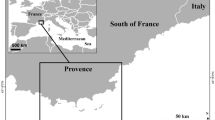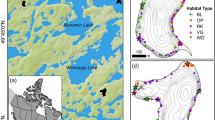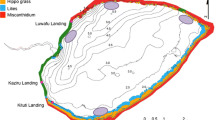Abstract
We used the rapid visual technique (RVT), an underwater visual assessment method developed in marine environments, to assess the influence of residential and cottage development on littoral zone fish communities in Pigeon Lake, a shallow, mesotrophic Canadian lake with extensive shoreline disturbance. We used RVT to assess 135 sites, stratified by degree of residential and cottage development (undeveloped, moderately developed, highly developed) and habitat type (three substrate/vegetation categories). Sites with different degrees of residential and cottage development did not differ significantly in species richness. When the RVT site scores of each species life stage (young-of-year, juveniles and adults) were compared among development categories, only 11% of species life stages showed significant differences; all were most abundant in moderately developed sites. Habitat had a greater influence than development on within-taxon abundance, as 46% of species life stages showed significant among-habitat differences in RVT score. The absence of significant fish community differences between developed and undeveloped sites may be due to the shallowness, extensive macrophyte cover and raised shorelines from the construction of the Trent-Severn Waterway. However, there do appear to be changes in the fish community over the last 35 years, as six cyprinids and one cyprinodont species that were present in Pigeon Lake in the 1970s were not detected by our sampling. RVT provided comparable data to that obtained by straight line transects on the relative abundance of species in the lake, but RVT was more effective at detecting species and life stages present at individual sites.
Similar content being viewed by others
References
Adams, P. & C. Taylor. 1992. Peterborough and the Kawarthas,2nd edition. Heritage Publications, Peterborough. 198 pp.
Angus, J.T. 1988. A Respectable Ditch: History of the Trent-Severn Waterway, 1833 –1920. McGill-Queen 's University Press, Kingston.455 pp.
Austin, D. 1998.The effects of cottage development on littoral fish habitat and fish communities in two lakes in southeastern Ontario. B.Sc. Thesis, Trent University, Peterborough. 38 pp.
Benson, B.J. & J.J.Magnuson. 1992. Spatial heterogeneity of littoral fish assemblages in lakes: Relation to species diversity and habitat structure. Can. J. Fish. Aquat. Sci. 49: 1493–1500.
Bryan, M.D. & D.L. Scarnecchia. 1992. Species richness, composition, and abundance of fish larvae and juveniles inhabiting natural and developed shorelines of a glacial Iowa lake. Environ. Biol. Fishes 35: 329–341.
Creed,Jr. R.P. & S.P. Sheldon. 1995. Weevils and watermilfoil: Did a North American herbivore cause the decline in an exotic plant?Ecol. Appl. 5: 1113–1124.
Engel, S. & J.L. Pederson Jr. 1998. The construction, aesthetics and effects of lakeshore development: A literature review. Wisconsin Department of Natural Resources, Research Report 177, Woodruff. 45 pp.
Evans, D.O.,K.H.Nicholls, Y.C. Allen & M.J. Mcmurtry. 1996. Historical land use, phosphorus loading, and loss of fish habitat in Lake Simcoe, Canada. Can. J. Fish. Aquat. Sci. 53 (Suppl.1): 194–218.
Gauch,Jr. H.G. 1982. Multivariate Analysis in Community Ecology. Cambridge University Press, New York. 298 pp.
Harding, J.S.,E.F. Benfield, P.V. Bolstad, G.S. Helfman. & E.B.D. Jones III. 1998. Stream biodiversity: the ghost of land use past. Proc. Nat. Acade. Sci. USA 95: 14843–14847.
Helfman, G.S. 1981. The advantage to fishes of hovering in shade. Copeia 1981: 392–400.
Hosn, W.A. & J.A. Downing. 1994. Influence of cover on the spatial distribution of littoral-zone fishes. Can. J. Fish. Aquat. Sci. 51: 1832–1838.
Jackson, D.A. & H.H. Harvey. 1993. Fish and benthic invertebrates: Community concordance and community –environment relationships. Can. J. Fish. Aquat. Sci. 50: 2641–2651.
Jackson, D.A. & H.H. Harvey. 1997. Qualitative and quantitative sampling of lake fish communities. Can. J. Fish. Aquat. Sci. 54: 2807–2813.
Jennings, M.J.,M.A. Bozrk, G.R. Hatzenbeler, E.E. Emmons & M.D. Staggs. 1999. Cumulative effects of incremental shoreline habitat modifications on fish assemblages in north temperate lakes. N. Am. J. Fish. Manage. 19: 18–27.
Jones, R.S. & M.J. Thompson. 1978. Comparison of Florida reef fish assemblages using a rapid visual technique. Bull. Mar. Sci. 28: 159–172.
Keast, A. & J.Harker. 1977. Strip counts as a means of determining densities and habitat utilization patterns in lake fishes. Environ. Biol. Fish. 1: 181–188.
Kimmel, J.J. 1985. A new species time method for visual assessment of fishes and its comparison with established methods. Environ. Biol. Fish. 12: 23–32.
Lynch, W.E. & D.L.Johnson. 1989. Influences of interstice size, shade, and predators on the use of artificial structures by bluegills. N. Am. J. Fish. Manage. 9: 219–225.
Pratt, T.C. & M.G. Fox. 1901a. Biotic influences on habitat selection by young-of year walleye (Stizostedion vitreum) in the demersal stage. Can. J. Fish. Aquat. Sci. 58: 1058–1069.
Pratt, T.C. & M.G. Fox. 1901b. Comparison of two methods for sampling a littoral zone fish community. Arch. Hydrobiol. 152: 687–702.
Randall, R.G.,C.K. Minns, V.W. Cairns & J.E. Moore. 1996. The relationship between an index of fish production and submerged macrophytes and other habitat features at three littoral areas in the Great Lakes. Can. J. Fish. Aquat. Sci. 53(Suppl.1): 35–44.
Sanderson, S.L. & A.C. Solonsky. 1986. Comparison of a rapid visual and a strip transect technique for censusing reef fish assemblages. Bull. Mar. Sci. 39: 119–129.
Scott,W.B. & E.J. Crossman. 1973. Freshwater Fishes of Canada. Bulletin 184, Fisheries Research Board of Canada Ottawa. 966 pp.
Weaver, M.J., J.J. Magnuson & M.K. Clayton. 1997. Distribution of littoral fishes in structurally complex macrophytes. Can. J. Fish. Aquat. Sci. 54: 2277–2289.
Werner, E.E. & D.J. Hall. 1988. Ontogenetic habitat shifts in bluegill: The foraging rate-predation risk trade-off. Ecology 69: 1352–1366.
Whittier, T.R. & R.M. Hughes. 1998. Evaluation of fish species tolerances to environmental stressors in the northeastern United States. N. Am. J. Fish. Manage. 18: 236–251.
Author information
Authors and Affiliations
Rights and permissions
About this article
Cite this article
Taillon, D., Fox, M. The influence of residential and cottage development on littoral zone fish communities in a mesotrophic north temperate lake. Environmental Biology of Fishes 71, 275–285 (2004). https://doi.org/10.1007/s10641-004-1261-x
Issue Date:
DOI: https://doi.org/10.1007/s10641-004-1261-x




